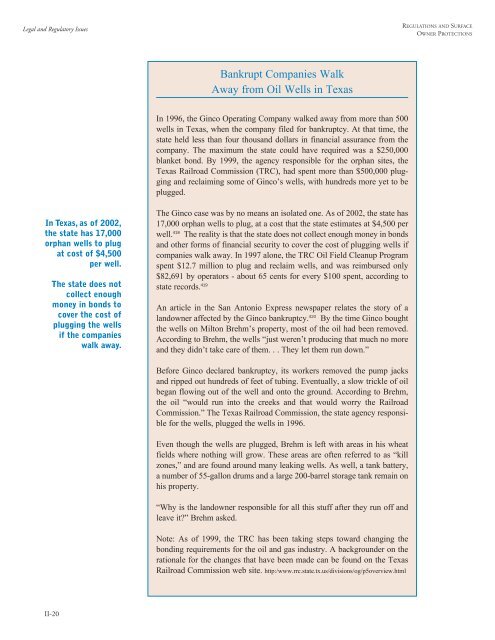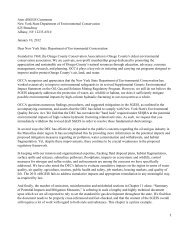Oil and Gas at Your Door? (2005 Edition) - Earthworks
Oil and Gas at Your Door? (2005 Edition) - Earthworks
Oil and Gas at Your Door? (2005 Edition) - Earthworks
Create successful ePaper yourself
Turn your PDF publications into a flip-book with our unique Google optimized e-Paper software.
Legal <strong>and</strong> Regul<strong>at</strong>ory Issues<br />
REGULATIONS AND SURFACE<br />
OWNER PROTECTIONS<br />
Bankrupt Companies Walk<br />
Away from <strong>Oil</strong> Wells in Texas<br />
In 1996, the Ginco Oper<strong>at</strong>ing Company walked away from more than 500<br />
wells in Texas, when the company filed for bankruptcy. At th<strong>at</strong> time, the<br />
st<strong>at</strong>e held less than four thous<strong>and</strong> dollars in financial assurance from the<br />
company. The maximum the st<strong>at</strong>e could have required was a $250,000<br />
blanket bond. By 1999, the agency responsible for the orphan sites, the<br />
Texas Railroad Commission (TRC), had spent more than $500,000 plugging<br />
<strong>and</strong> reclaiming some of Ginco’s wells, with hundreds more yet to be<br />
plugged.<br />
In Texas, as of 2002,<br />
the st<strong>at</strong>e has 17,000<br />
orphan wells to plug<br />
<strong>at</strong> cost of $4,500<br />
per well.<br />
The st<strong>at</strong>e does not<br />
collect enough<br />
money in bonds to<br />
cover the cost of<br />
plugging the wells<br />
if the companies<br />
walk away.<br />
The Ginco case was by no means an isol<strong>at</strong>ed one. As of 2002, the st<strong>at</strong>e has<br />
17,000 orphan wells to plug, <strong>at</strong> a cost th<strong>at</strong> the st<strong>at</strong>e estim<strong>at</strong>es <strong>at</strong> $4,500 per<br />
well. 418 The reality is th<strong>at</strong> the st<strong>at</strong>e does not collect enough money in bonds<br />
<strong>and</strong> other forms of financial security to cover the cost of plugging wells if<br />
companies walk away. In 1997 alone, the TRC <strong>Oil</strong> Field Cleanup Program<br />
spent $12.7 million to plug <strong>and</strong> reclaim wells, <strong>and</strong> was reimbursed only<br />
$82,691 by oper<strong>at</strong>ors - about 65 cents for every $100 spent, according to<br />
st<strong>at</strong>e records. 419<br />
An article in the San Antonio Express newspaper rel<strong>at</strong>es the story of a<br />
l<strong>and</strong>owner affected by the Ginco bankruptcy. 420 By the time Ginco bought<br />
the wells on Milton Brehm’s property, most of the oil had been removed.<br />
According to Brehm, the wells “just weren’t producing th<strong>at</strong> much no more<br />
<strong>and</strong> they didn’t take care of them. . . They let them run down.”<br />
Before Ginco declared bankruptcy, its workers removed the pump jacks<br />
<strong>and</strong> ripped out hundreds of feet of tubing. Eventually, a slow trickle of oil<br />
began flowing out of the well <strong>and</strong> onto the ground. According to Brehm,<br />
the oil “would run into the creeks <strong>and</strong> th<strong>at</strong> would worry the Railroad<br />
Commission.” The Texas Railroad Commission, the st<strong>at</strong>e agency responsible<br />
for the wells, plugged the wells in 1996.<br />
Even though the wells are plugged, Brehm is left with areas in his whe<strong>at</strong><br />
fields where nothing will grow. These areas are often referred to as “kill<br />
zones,” <strong>and</strong> are found around many leaking wells. As well, a tank b<strong>at</strong>tery,<br />
a number of 55-gallon drums <strong>and</strong> a large 200-barrel storage tank remain on<br />
his property.<br />
“Why is the l<strong>and</strong>owner responsible for all this stuff after they run off <strong>and</strong><br />
leave it?” Brehm asked.<br />
Note: As of 1999, the TRC has been taking steps toward changing the<br />
bonding requirements for the oil <strong>and</strong> gas industry. A backgrounder on the<br />
r<strong>at</strong>ionale for the changes th<strong>at</strong> have been made can be found on the Texas<br />
Railroad Commission web site. http:/www.rrc.st<strong>at</strong>e.tx.us/divisions/og/p5overview.html<br />
II-20




